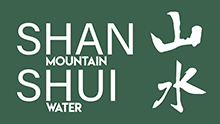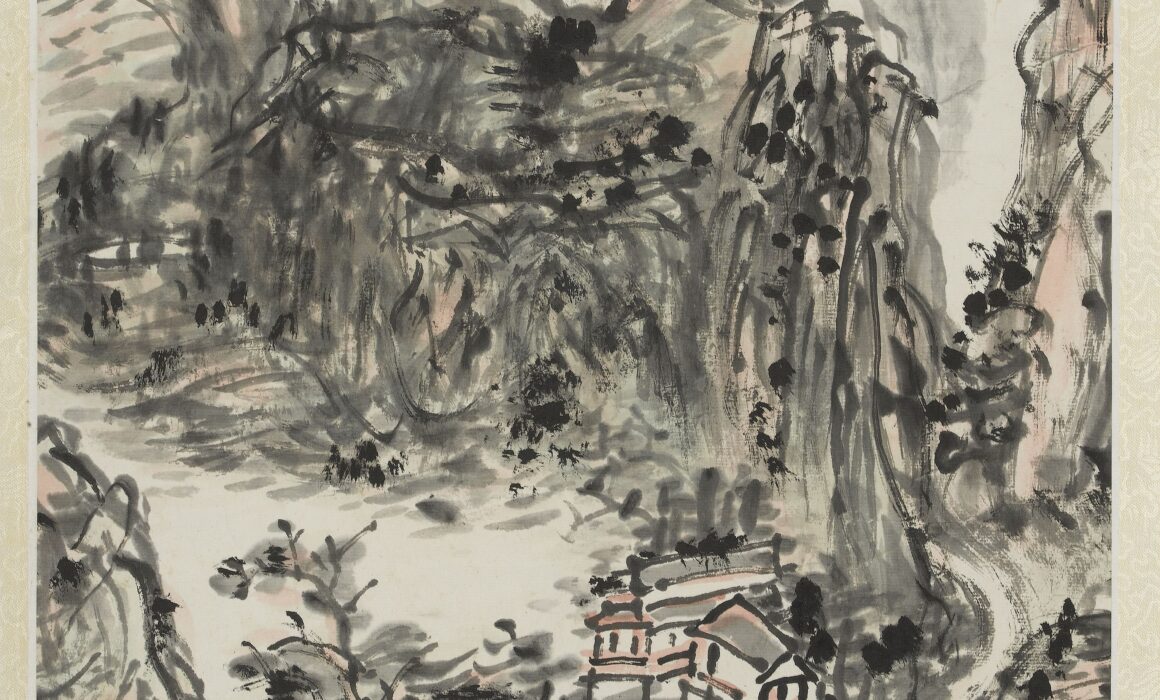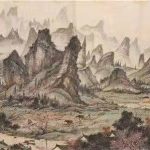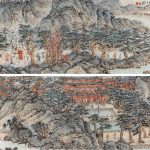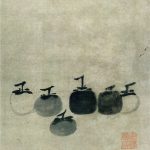The bifa concept in Jing Hao’s Bifaji
A brief study of its continuity and significance in Mountain and water painting (Part II)
Issue 2 – By; Claudio D. Lucchi
2.4. Bifa’s universal character
As it sets out to explore Jing Hao’s bifa concept, what may strike a Western mind more than anything else might well be its universal character. It relies on the cosmic vision developed by Chinese philosophers since ancient times, which has greatly influenced Chinese aesthetics and arts up to our present day.
It is important to grasp the essence of the Chinese worldview, given that it strongly differs from the Christian one and has thus given birth to a system of thought which might be described as “subtly different” since it sometimes appears to reach results and conclusions similar to those proposed in the West and yet does so while relying on very disparate fundamentals.
It might here suffice to cite two extracts, the first from Lao Zi’s Daode Jing 《道德经》 , and the second one from Liu An’s Huainanzi《 淮南子》:
The Tao produced One; One produced Two; Two produced Three; Three produced All things.[1]
道生一,一生二,二生三,三生萬物。[2]
One is the origin of all creatures, it is the Dao under its absolute form.
一也者,萬物之本也,無敵之道也。《淮南子 • 詮言訓》[3]
According to this philosophical vision, the origin of all things and of the world itself proceeds from the Absolute One (yi 一) which, according to Pierre Ryckmans[4], stands for the Absolute in its original state before it divided, thus giving birth to the myriad things (wanwu 萬物) that fill the universe. As already noted above, something analogous to cosmic creation happens in painting: starting from plain silk or paper, the painter “reenacts” the creative process by gradually dividing heaven and earth and giving life and shape to all things within his microcosm, i.e., his painting. According to François Jullien, Chinese painters “do not invent a world other than this one”. They take care not to “alter or even disturb its coherence” but rather “join with that coherence through painting”.[5]
Jullien goes one step further and concludes that having “carefully balanced” and perfected Chinese painting over the centuries, Chinese painters now seem content to simply maintain and perpetuate it, constantly reasserting its guiding principles.[6] To further illustrate this point, Jullien draws on some selected statements by the famous 20th century painter Qi Baishi 齐白石 (1864-1957).
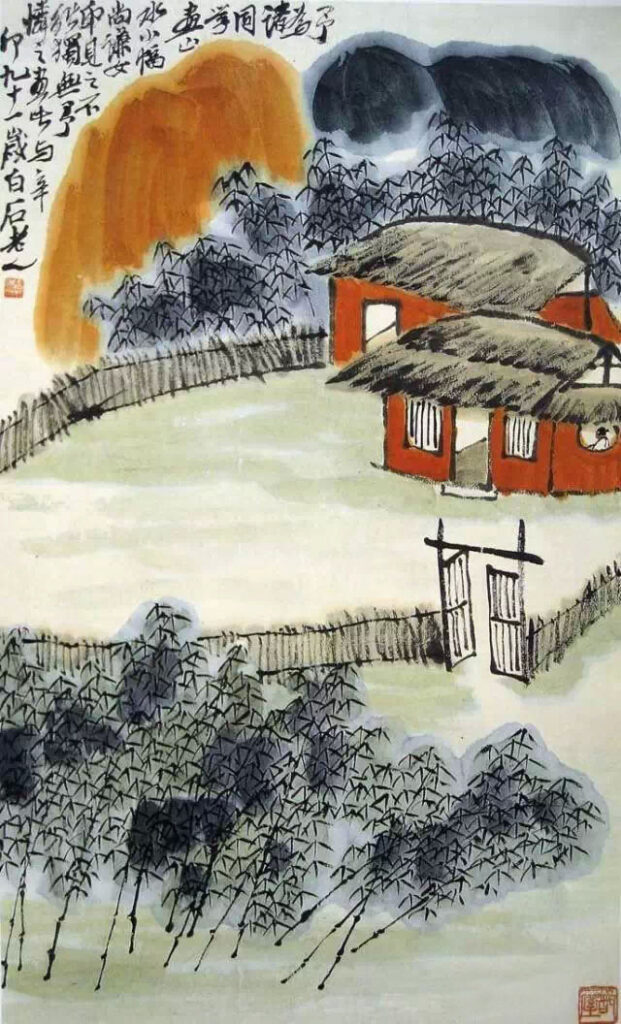
Mountain and Water 《山水小幅》 1951
From a purely painterly standpoint, one may wonder why Jullien chose to cite Qi Baishi instead of Huang Binhong 黄宾虹 (1865-1955), whose impressive literary corpus on Chinese painting certainly surpasses that of his contemporary. If this might additionally demonstrate how Huang Binhong’s oeuvre still seems to tarry in a state of half-light both in China and abroad, while Qi Baishi’s work enjoyed (and still does enjoy) greater and more widespread reputation already during both mens’ artistic career, Jullien’s choice of reference may still be viewed as a minor detail which does not undermine the correctness of his statement. However, a few explanatory words might be added to offer ampler insight into a topic that could be described as rather entangled, especially from a Western stance, particularly now that China is readjusting its values while attempting to reconcile thousands-year old concepts with Western ideals.
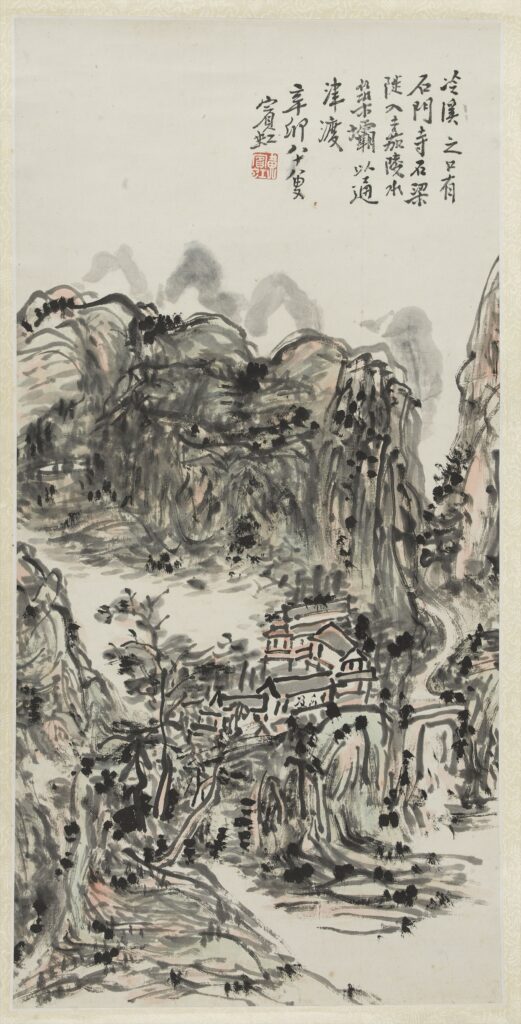
Mountain and Stream 《山水小品冷溪之口》 67×33
Despite the subtle changes and contributions that Chinese artists introduced (and are still introducing) in Chinese painting over the last centuries, one point cannot be denied: the key concepts lying at the foundation of Chinese painting remain unchanged. Hence, the repetitions seen by François Jullien are in a way inevitable. This is illustrated, among others, by the endless reiterations that may be found in numerous treatises whose authors simply quote or paraphrase ancient texts so as to assert their adhesion to the tradition and demonstrate that they, too, understand and follow the ancients (shifa guren 师法古人). But accomplished Chinese painters do not restate concepts established by the ancient masters out of mere pedantry. They do so because before making a contribution of their own, they deem it necessary to first absorb the ever-growing heritage that has been passed down to them since Antiquity.
Given that according to Chinese philosophy, everything finds its source in the Absolute One (yi 一), theoretically, practitioners of Chinese painting must be conscious that painting, far from being an end to itself, belongs to a system of thought that encompasses all aspects of human life and that, more than an art form, is what François Cheng describes as an “art of life”.[7]
The same ideals apply to Jing Hao’s bifa concept, which he did not create, so to speak, out of the blue. His whole treatise may be described as the result of a life-long process of self-cultivation and gradual absorption of philosophical and artistic concepts. Kiyohiko Munakata saw in Jing Hao’s Bifaji an attempt to propose a balanced synthesis of Taoist and Confucian principles[8]. It is relevant to note that this very attempt, as well as some of the concepts it discusses, all reveal a clear analogy between the Bifaji and Liu Xie’s 刘勰 Wenxin Diaolong 《文心雕龍》 (The Literary Mind and the Carving of Dragons). In his work, Liu Xie drew upon the same philosophic fundamentals as did Jing Hao, a fact which further illustrates the universal character of Chinese arts and of the bifa concept.
Since its inception, Jing Hao’s bifa concept has been handed down from one generation of painters to the next, each painter first receiving it and then enriching it through his own artistic philosophy and creation. Hence, Jing Hao’s bifa may also be found in Shitao’s 石涛 treatise on painting Kugua Heshang Huayu Lu 《苦瓜和尚畫語錄》, reasserted, and further developed and expanded through Shitao’s own concept of the Unique Brushstroke (yihua 一畫). In modern times, Jing Hao’s bifa concept lives on in the art view of Huang Binhong, among others, who greatly emphasised the importance of carrying out artistic innovation through tradition.
Here, I consider it worthwhile to expand a little on Huang Binhong’s artistic views, especially since Huang Binhong may be regarded as the most prolific and influential Chinese painting theorist of 20th century China. Although widespread recognition of his oeuvre and writings came rather late, in the early 1980s, Huang Binhong is hailed, along with Wu Changshuo 吴昌硕 (1844-1927), Qi Baishi 齐白石, and Pan Tianshou 潘天寿 (1897-1971), as one of the most accomplished Chinese masters of the 20th century.
One does not need to go beyond the opening lines of The Essence of Painting (Huafa Yaozhi 画法要旨)[9] to find, neatly expressed, Huang Binhong’s personal view of the bifa concept and its role in Chinese painting.
The art of the brush (bifa 筆法), ink (mofa 墨法), and composition (zhangfa 章法) are the three main points [to be observed in painting]. No one can possibly expect to disregard brush-and-ink (bimo 筆墨), relying solely and blindly on composition, yet improve and establish oneself, and set a long-lasting example for posterity.
筆法、墨法、章法,三者爲要,未有無筆無墨,徒襲章法,而能克自樹立,垂諸久遠者也。[10]
Huang Binhong’s statement clearly follows that of Jing Hao: the brush (bi 笔) cannot be treated as a mere tool, or a set of technical rules. In his essay, he did however greatly develop the 10th century master’s views. Faithful to the Chinese concept of inheritance and perpetuation, Huang Binhong took care to first absorb the contributions made by older masters, such as Shitao and Dong Qichang 董其昌, to Jing Hao’s bifa concept, thus causing his own bifa concept to be the result of the accumulation and reinterpretation of earlier concepts.

Cypress and house《柏屋图》 229×34
It would not be enough to say that Huang Binhong treated the bimo 笔墨 concept[11] as the heart and soul of Chinese painting. In his oeuvre, brush-and-ink (bimo 笔墨) becomes the painter’s language, the vessel of his emotions, imbued with the painting’s spirit. If the brush is flawed (i.e., handled improperly), the whole painting is lost. In the opening remarks of his essay, composition comes as a mere third (after brush and ink) and is one aspect painters should not trouble themselves with until they have not fully mastered the art of brush-and-ink.[12] Students should first devote their attention to the careful copy of ancient masterpieces, perfecting their brush-and-ink and ipso facto assimilating the compositional traits of the original works.[13] Incidentally, it becomes obvious that here, ancient masterpieces are not treated as a mere source of technical training, but as actual spiritual nourishment.
Jason C. Kuo has argued that in so doing, Huang Binhong actually liberated brush-and-ink from its conventional subject matter[14], thus allowing later generations of painters to engage themselves with the world of abstract forms. In theory, anything — i.e., not just mountains and waters, or animals and plants — may be depicted as long as brush and ink are handled properly. Huang Binhong himself illustrated this point, as he virtually kept on painting the same mountain scapes decade after decade, with little variation in terms of composition. In this, he partly redefined what had been asserted by Shitao in his famous treatise. The latter laid great emphasis on the individualistic quality of the painterly act, as may be seen in the seventh chapter of his Kugua Heshang Huayu Lu 《苦瓜和尚畫語錄》:
At this point, even though the brush, the ink, the painting, everything would abolish itself, the Self would still subsist, existing by itself.[15]
縱使筆不筆,墨不墨,畫不畫,自有我在。[16]
Within Huang Binhong’s art view, Shitao’s idea doesn’t work anymore, since the painter’s ego now finds itself embedded in the brush-and-ink concept.
Through this brief outlining of the evolution and transformation of the bifa concept at the hand of various painters in different eras, one may see how Chinese painting and bifa have kept on developing unto our day, untouched by any revolution or schism. This is also how one should understand François Jullien’s above-mentioned assertion: no new development, change or contribution introduced by contemporary painters should in any way unsettle the already established system of Chinese painting which, like a delicate clockwork, has been (and still is) carefully and constantly perfected and maintained throughout the centuries.
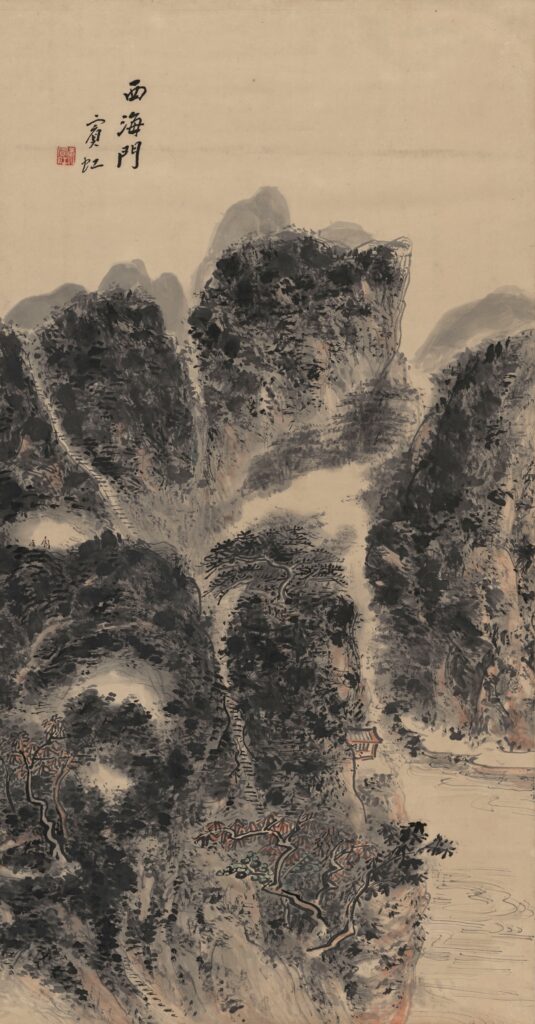
Xii Haimen 《西海们图轴》88×64
This particular attitude towards art hails from a broader outlook on life and the universe in general, built on harmony and balance, and the preservation thereof.
Man is tranquil when born, and this is his divine nature (tianxing 天性). As he is activated by sensation, his nature is injured. As he perceives matter (wu 物) and responds to it with the spirit (shen 神), knowledge is activated. When knowledge and matter meet in conjunction, the passions are awakened. When passions assume form (xing 形), man recognizes external stimuli. He will not be able to deny this in himself. Thus, divine principles (tianli 天理) perish. Those who arrive at the Tao do not permit themselves to deviate from the Divine. Though externally they transform as do natural phenomena (wu 物), internally they maintain clarity of mind (qing 情).[17]
人生而静,天之性也;感而后动,性之害也;物至而神应,知之动也;知与物接,而好憎生焉。好憎成形而智诱于外,不能反己,而天理灭矣。故达于道者,不以人易天;外与物化,而内不失其情。《淮南子 • 原道训》
In these concepts lies one major difference with Christian thought, which quite naturally influenced the development of Western thought and arts. Men are born into the world defiled by sin and there is nothing that they may do or say that will in any way alter their state. This is why Christian thought recognises that only Divine (i.e., external) intervention may bring about spiritual redemption (Solo Gratia). One short passage from the Holy Scriptures may well illustrate this point:
For whosoever will save his life shall lose it: but whosoever will lose his life for my sake, the same shall save it.
For what is a man advantaged, if he gain the whole world, and lose himself, or be cast away? (Luke 9:24, 25) [18]
Men should first and foremost care about spiritual salvation. Everything earthly should be of little concern, for life on this earth is but “a shadow of things to come” (Colossians 2:17). Blaise Pascal clearly expressed this idea in the Pensées :
The immortality of the soul is one thing which matters so much to us, and which touches us so profoundly, that one must needs have lost all sentiment in order to be indifferent about it.[19]
This is also why longevity and old age are not viewed as something “desirable” since these too are bodily attributes which do only concern this earthly life.[20]
Furthermore, one must keep in mind that Chinese painting and the Chinese system of thought have kept on developing since ancient times following one single and uninterrupted line, unperturbed by any revolution that might even come close in scope to what the Italian philosopher Benedetto Croce described, in his assessment of the position of Christianity within Western culture, as the “greatest revolution ever accomplished by humanity, so great, so comprehensive and profound, so rich in consequences, so unexpected and irresistible in its taking place […].”[21]
The forsaking, or rather, the voluntary casting away of an ideology or concept deemed redundant or even harmful lies at the heart of the Christian spirit. As one reflects on the Christian fundamentals, it may become easier to understand why history, although an important source of teachings and information, is not regarded as something whose continuity must be carefully preserved (as may be seen in the handing down of the Chinese painting tradition). Every man must individually learn to “know” God and “walk in His ways”. Despite the historical corpus of theological writings slowly accumulated through the centuries, beginning with the first written Law given to Moses and the teachings of Jesus Christ, all the way through Paul the Apostle, the Doctors of the Church, until the Protestant theologians and reformers, the concept of faith (that is, not the body of teachings normally referred to as the Christian Faith, but that very and unique strength to believe in God and follow in His ways) is something that is totally impossible to impart or inherit. In this sense, every generation, every individual must start anew. Seen from this angle, and transposed to painting, it becomes easier to understand the Western painter’s individualistic stance, as opposed to the collective viewpoint of the Chinese painter.
Perhaps more important still is the Christian worldview, which recognises the universe as the calculated and conscious creation of a being superior to man, i.e., God, who is absolutely not a part of His Creation but exists outside time and space, having created them too. This implies that the universe as we know it may have an end, an idea which Chinese philosophers appear to have left untouched (since the Dao is treated as a “principle”, or “self-winding mechanism”, there is indeed no need to foresee such an issue). While Chinese painters concentrate their attention on the principles (li 理) that underlie creation, Christian thought focuses on understanding the Mind that shaped it. In the words of Paul Cézanne (in a discussion on painting with Émile Bernard): “Je me tourne vers l’intelligence du Pater Omnipotens”.[22] Following such a line of thought, the idea of attuning oneself with the universe (which, as a part of creation, is inferior to the Creator) loses its meaning and the painting brush becomes nothing more than a tool with which the painter expresses his thought.
3. Conclusion: bifa’s transmission and self-regeneration
The technical mastery of the brush is but a part of Jing Hao’s much broader bifa concept. The handling of the brush itself does not rest on simple painterly needs, but on philosophical views.
One anecdote from the Lidai Minghua Ji may further illustrate the unique importance attributed to the brush by Chinese painters and critics:
There was a clever painter who said of himself that he could paint cloud vapours. I said to him: “The ancients never reached this final subtlety in their painting of clouds. If one moistens silk, dotting and filling in here and there with a light powder blown from the mouth, this is known as blown clouds. Such [a technique] is in accord with the principles of Heaven, but, though it may be called a subtle solution, one cannot see the brushstrokes in it, therefore it cannot be called painting.[23]
有好手画人,自言能画云气。余谓门:古人画云,未为臻妙。若能沾湿绡素,点缀轻粉,纵口吹之,谓之吹云。此得天理,虽曰妙解,不见笔踪,故不谓之画。
Characterised by its dual philosophical-technical nature, the bifa concept can be regarded as an indispensable element in Chinese painting. This does also make it quite difficult to accurately define its essence, given that it belongs as much to the world of visible forms (xing 形) as to that of the spirit (shen 神). Huang Binhong once remarked :
As one abandons the rule, it becomes impossible to fully unfold the brush’s exquisiteness (miao 妙) ; as one allows himself to be restrained by the rule, one cannot fully use the brush’s divine (shen 神) essence.[24]
离于法,无以尽用笔之妙;拘于法,不能全用笔之神。[25]
As it draws on fundamental philosophical concepts, Jing Hao’s bifa concept finds its source outside the world of Chinese painting. Handed down from one generation of painters to the next, bifa has come to us enriched, expanded, and yet unchanged in its essence. And just as Chinese painting, so will bifa be further enriched and developed by our generation of painters before being passed on to the next one.

405×30.5, 1952
Read the article from the magazine
[1] James Legge (tr.), The Texts of Taoism (Part I), Dover Publications, New York, p. 85.
[2] 《老子 • 第四十二章》
[3] Cited by Pierre Ryckmans in : Pierre Ryckmans, Les propos sur la peinture de Shi Tao – Traduction et commentaire, Arts asiatiques, Tome 14, 1966, p. 85. (Personal translation from the original French text.)
[4] Ibid.
[5] François Jullien (translated by J.M. Todd), The Great Image Has Not Form, On the Nonobject through Painting, The University of Chicago Press, Chicago and London, p. 116
[6] François Jullien, p. 117
[7] François Cheng, Souffle-Esprit, Éditions du Seuil, 2006, p. 161.
[8] Munakata, pp. 3-4.
[9] The Essence of Painting 画法要旨 was first published in 1934, in the monthly magazine Guohua Yuekan 国画月刊, and is one of Huang Binhong’s most important essays on the art of Chinese painting. In it, he laid down what he deemed as the essence, or the vital points of Chinese painting, and developed his own particular concept of bimo 笔墨, that is, of the art of handling brush and ink, commonly referred to as wubi qimo 五笔七墨.
[10] 《黄宾虹文集·书画编·上册》,上海书画出版社,1999年,p. 489.
[11] In The Essence of Painting, Huang Binhong pointed out that ancient masters always treated brush and ink separately, failing to unite them. Huang Binhong insisted on bringing them together, arguing that the two are complementary, since none can work without the other. In doing so, he did however raise the brush above the ink (see passage quoted above).
[12] 《黄宾虹文集·书画编·上册》,上海书画出版社,1999年,p. 490.
[13] Ibid.
[14] Jason C. Kuo, Chinese Ink Painting Now, Timezone 8, Hong Kong 2010.
[15] Pierre Ryckmans, Les propos sur la peinture de Shi Tao – Traduction et commentaire, Arts asiatiques, Tome 14, 1966, p. 107. (Personal translation from the original French text.)
Cf. Lin Yutang’s translation of the same text : “Then, even if the brush and ink and the drawings are all wrong, the ‘me’, the ‘self’, remains there.” (Lin Yutang, The Chinese Theory of Art, G. P. Putnam’s Sons, New York, p. 146.)
[16] 石涛《苦瓜和尚画语录 · 絪缊章第七》
[17] Susan Bush & Hsio-yen Shih, Early Chinese Texts on Painting, p. 3.
[18] The Holy Bible (KJV), Trinitarian Bible Society, London.
[19] Blaise Pascal, Pensées, Collection Maxi-Poche Classiques Français, Bookking International, Paris, 1995. (Personal translation of the original French text.)
[20] For a study on this subject, see : Jerome Silbergeld, Chinese Concepts of Old Age and Their Role in Chinese Painting, Painting Theory, and Criticism, Art Journal, 1987, pp. 103-114 .
[21] Benedetto Croce, Perché non possiamo non dirci «cristiani», published in Discorsi di varia filosofia, Vol. I, Laterza, Bari, 1945. (Personal translation of the original Italian text.)
[22] Cited by Maurice Merleau-Ponty in his essay, Le doute de Cézanne, published in Sens et non-sens, Éditions Gallimard, 1996, pp. 13-33.
[23] Susan Bush & Hsio-yen Shih, Early Chinese Texts on Painting, p. 63.
[24] Personal translation.
[25] 王伯敏 编,《黄宾虹画语录》,上海人民美术出版社,上海,1978,p. 30
